ISSN ONLINE(2278-8875) PRINT (2320-3765)
ISSN ONLINE(2278-8875) PRINT (2320-3765)
Vibha.C.Amboji1, Mrs.Pankaja.B.Patil2, Swati.S.Killikatt3
|
| Related article at Pubmed, Scholar Google |
Visit for more related articles at International Journal of Advanced Research in Electrical, Electronics and Instrumentation Engineering
The work is carried on to design of a networked system for joint compression, rate control and error correction of video over resource-constrained embedded devices based on the theory of compressed sensing. The objective of this work is to design a cross-layer system that jointly controls the video encoding rate, the transmission rate, and the channel coding rate to maximize the received video quality. It is shown that compressed sensing can overcome many of the current problems of video over WMSNs, primarily encoder complexity and low resiliency to channel errors. A rate controller is then developed with the objective of maintaining fairness among video streams while maximizing the received video quality and the packets reconfiguration if there is any loss in the packet. It is shown that the rate of compressed sensed video can be predictably controlled by varying only the compressed sensing sampling rate. The rate controller is shown to outperform existing TCP-friendly rate control schemes in terms of received video quality.
Keywords |
| Compressed Sensing, Network Optimization, Multimedia Streaming, Congestion Control, Sensor Networks. |
INTRODUCTION |
| Wireless Multimedia Sensor Networks (WMSN)[6] are self-organizing systems of embedded devices deployed to retrieve, distributively process in real-time, store, correlate, and fuse multimedia streams originated from heterogeneous sources. WMSNs are enablers for new applications including video surveillance, storage and subsequent retrieval of potentially relevant activities, and person locator services. The key problem of enabling real-time qualityaware video streaming in large-scale multi-hop wireless networks of embedded devices is still open and largely unexplored. There are two key shortcomings in systems based on sending predictively encoded video (e.g., MPEG- 4[3]) through a layered wireless communication protocol stack, i.e., encoder complexity and low resiliency to channel errors. |
| MPEG (aka H.222/H.262[4] as defined by the ITU) is a standard for "the generic coding of moving pictures and associated audio information". It is designed to compress raw digital video and audio down to 1.5 Mbit/s. It describes a combination of lossy video compression and lossy audio data compression methods, which permit storage and transmission of movies using currently available storage media and transmission bandwidth. |
| In existing layered protocol stacks based on the IEEE 802.11 and 802.15.4 standards, frames are split into multiple packets. If even a single bit is flipped due to channel errors, after a cyclic redundancy check, the entire packet is dropped at a final or intermediate receiver. This can cause the video decoder to be unable to decode an independently coded (I) frame, thus leading to loss of the entire sequence of video frames. |
| New cross-layer optimized wireless system based on the recently proposed compressed sensing (CS) [5] paradigm can offer a promising solution to the aforementioned problems so this technique is used even though there are many compression techniques like MPEG,JPEG. Compressed sensing (“compressive sampling”) can offer an alternative to traditional video encoders by enabling imaging systems that sense and compress data simultaneously at very low computational complexity for the encoder. |
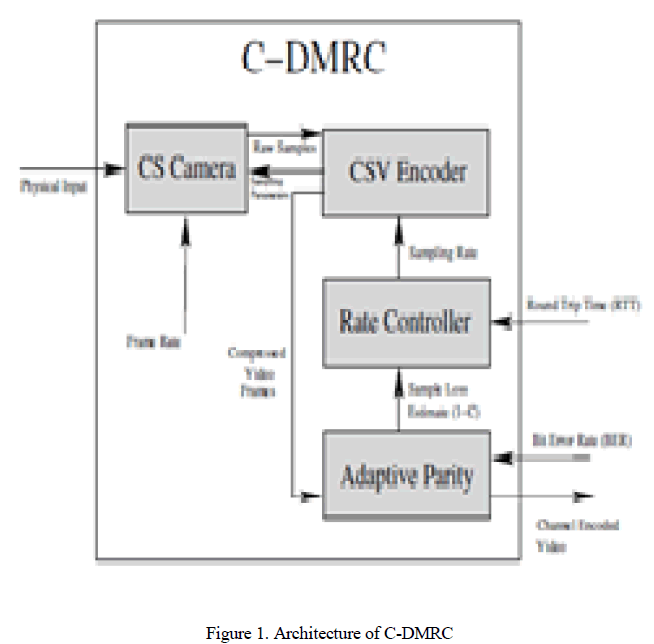 |
| Contributions made by C-DMRC are: |
| 1. Video Transmission Using Compressed Sensing. |
| 2. Distortion-based Rate Control. |
| 3. Rate Change Aggressiveness Based on Video Quality. |
| As transmission of CS images and video streaming in wireless networks, and their statistical traffic characterization, are substantially unexplored thus the Compressive Distortion Minimizing Rate Control (C-DMRC), a new distributed cross layer control paradigm that jointly regulates the CS sampling rate, the data rate injected in the network, and the rate of a simple parity-based channel encoder to maximize the received video quality over a multi-hop wireless network with lossy links. |
| The remainder of this paper is structured as follows. In Section II, related work is discussed. In Section III the CDMRC system architecture is introduced. In Section IV results are presented. In Section V conclusion and future work are discussed. |
RELATED WORK |
| The most common rate control scheme is the well-known transmission control protocol (TCP) [9]. Because of the additive increase/multiplicative-decrease algorithm used in TCP, the variation in the rate determined by TCP can be very distracting for an end user, resulting in poor end user perception of the video quality . In addition, TCP assumes that the main cause of packet loss is congestion [10], and thus misinterprets losses caused by channel errors as signs of congestion. These considerations have led to a number of equation-based rate control schemes, which analytically regulate the transmission rate of a node based on measured parameters such as the number of lost packets and the round trip time (RTT ) of the data packets. Two examples of this are the TCP-Friendly Rate Control[1][10], which is used to determine a source rate that is fair to TCP streams. However, in a WMSN, priority must be given to the delay-sensitive flows at the expense of other delay-tolerant data. Therefore, TCP result in a transmission rate that is more conservative than the optimal rate. For this reason, in an effort to optimize resource utilization in resource-constrained WMSNs, our scheme does not take TCP fairness into account. |
SYSTEM DESIGN |
| Compressive Distortion Minimizing Rate Control (C-DMRC) [11], a new distributed cross-layer control algorithm that jointly regulates the CS sampling rate, the data rate injected in the network, and the rate of a simple parity-based channel encoder to maximize the received video quality over a multi-hop wireless network with lossy links. Also, because all compressed samples are equally important, the loss of samples will only effect the quality of the received image proportional to the number of samples lost.The cross-layer architecture of our proposed integrated congestion control and video transmission scheme is shown in Figure 2. Figure 2. |
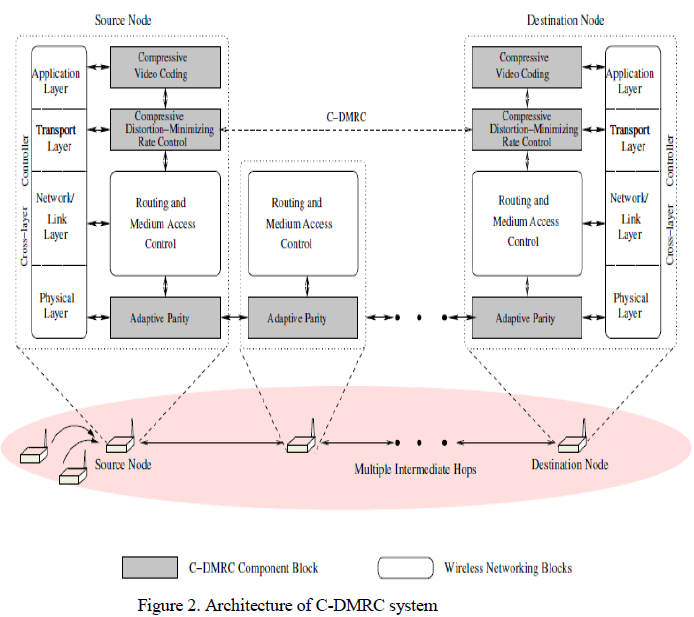 |
| By jointly controlling the compressive video coding at the application layer, the rate at the transport layer, and the adaptive parity at the physical layer, information is leveraged at all three layers to develop an integrated congestionavoiding and distortion-minimizing system. |
| Following are some contributions: |
| Video Transmission Using Compressed Sensing: By using the difference between the CS samples of two frames, we can compress the frames based on the temporal correlate on at low complexity. |
| Distortion-based Rate Control: C-DMRC leverages the estimated received video quality as the basis of the rate control decision. The transmitting node controls the quality of the transmitted video directly. Since the data rate of the video is linearly dependent on the video quality, this effectively controls the data rate. By controlling congestion in this way, short-term fairness in the quality of the received videos is maintained even over videos that have very different compression ratios. |
| Rate Change Aggressiveness Based on Video Quality: With the proposed controller, nodes adapt the rate of change of their transmitted video quality based on an estimate of the impact that a change in the transmission rate will have on the received video quality. The rate controller uses the information about the estimated received video quality directly in the rate control decision. |
 |
| (1) which represents the difference of the weighted average over the previous N received RTT measurements with and without the most recent measurement. |
| If the sending node estimates that the received video quality is high, and round trip time measurements indicate that current network congestion condition would allow a rate increase, the node will increase the rate less aggressively than a node estimating lower video quality and the same round trip time. Conversely, if a node is sending low quality video, it will gracefully decrease its data rate. |
A. METHODOLOGY: |
| A block diagram of this architecture is illustrated in Figure 3. The video sequence is first divided into Group Of Pictures (GOPs). The first frame of each GOP, also referred to as key frame, is encoded using a conventional intraframe coding technique such as H.264/AVC in intra-frame mode. The remaining frames in a GOP are encoded using distributed coding principles and are referred to as WZ frames. In a pixel-domain WZ version, the WZ frames first undergo quantization. Alternatively, in a transform-domain version, a DCT transform is applied prior to quantization. |
| The quantized values are then split into bit-planes which go through a Turbo encoder. At the decoder, SI approximating the WZ frames is generated by motion-compensated interpolation or extrapolation of previously decoded frames. The SI is used in the turbo decoder, along with the parity bits of the WZ frames requested via a feedback channel, in order to reconstruct the bit- planes, and subsequently the decoded video sequence. |
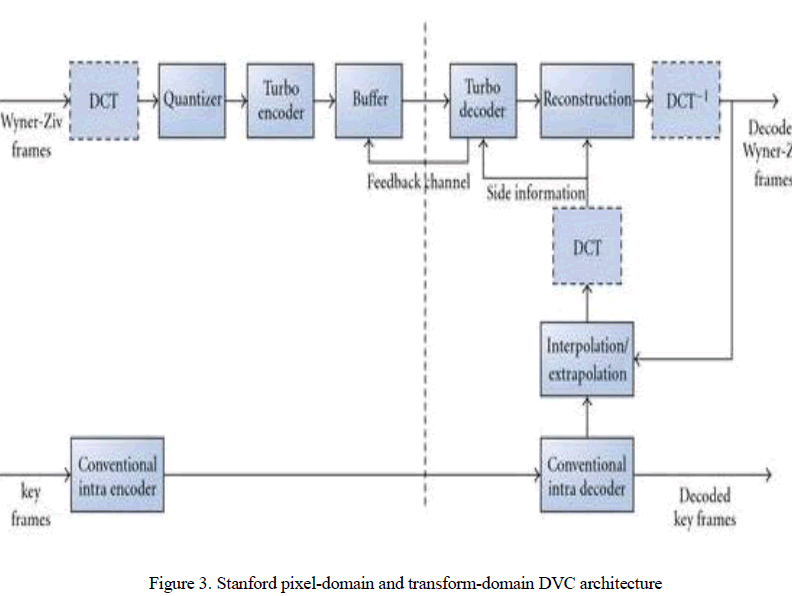 |
EXPERIMENTAL SETUP AND RESULTS |
| To get the desired results which are based on Pentium-4, 2 GB- RAM, 40GB-Hard Disk, OpenCv 2.4.3 with Microsoft Visual Studio 2008. |
| There are three modules being used they are client, router and servers which are used for sending the requested compressed file form servers to client through router. |
1.CLIENT: |
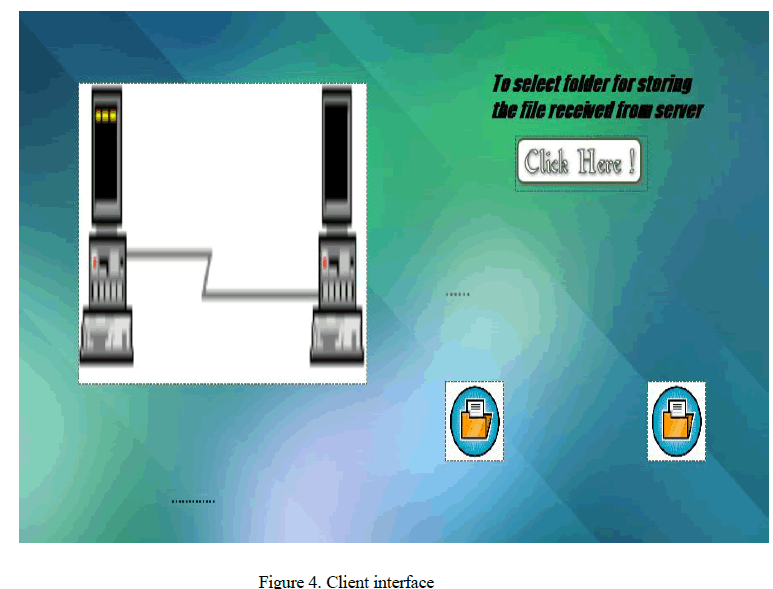 |
| Client requests the servers for the data by selecting the path to receive data which is done by clicking on click here. |
2.SERVER_1: |
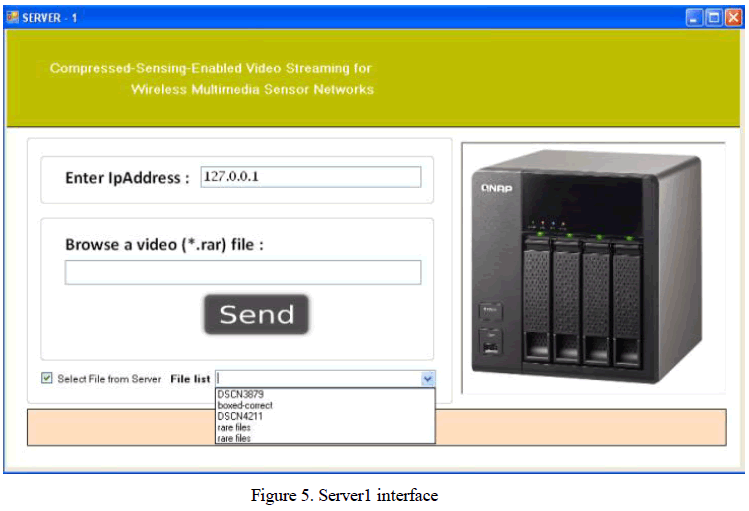 |
| After the client requests for data, server responds to the specific client by knowing the IP address, where the compressed file is selected from drop-down file list and send button is clicked to transfer the file. |
3.SERVER_2: |
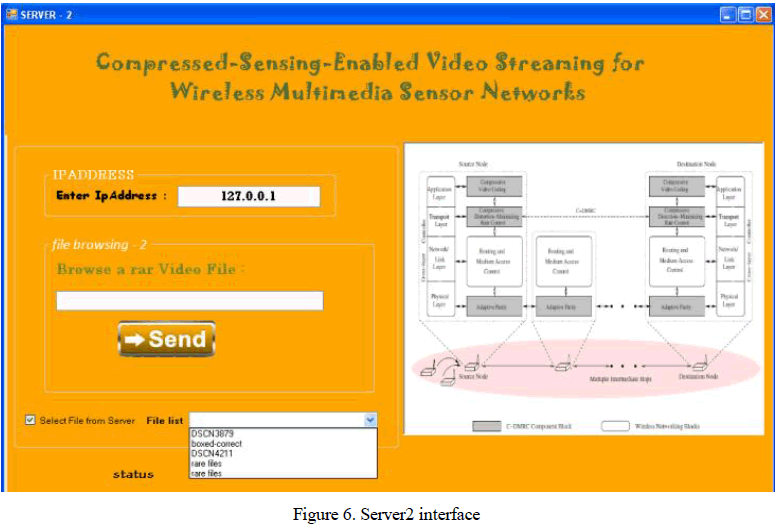 |
| Client can request data from many servers thus after requesting file the server responds to the specific client by knowing the IP address, where the compressed file is selected and the send button is clicked. |
4.ROUTER: |
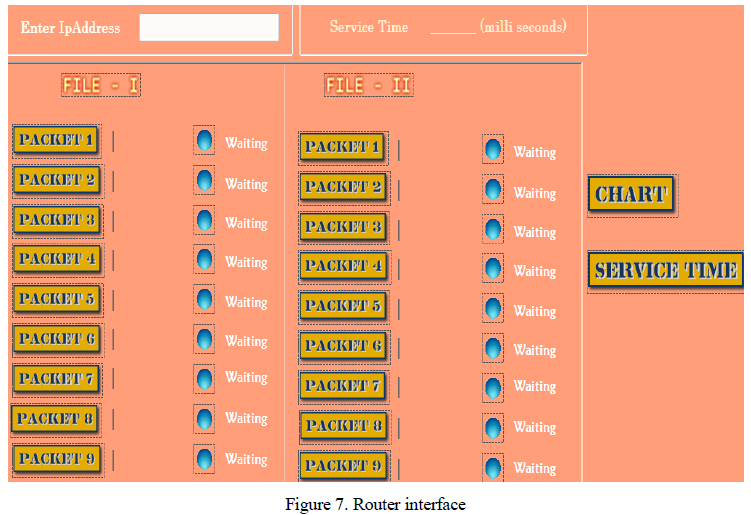 |
| Initially the IP Address has to be entered and when the client request for the file and server sends a file which will be passed through many nodes and routers and as the file is sent which is divided into packets which are numbered, here each file will be divided into ten packets. |
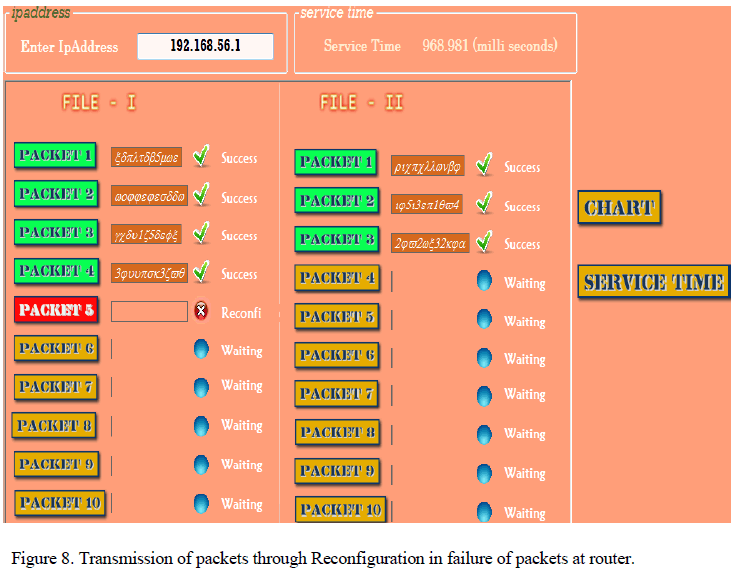 |
| As the packets are sent the next packet is not received until the current packet is received completely, as shown in above figure 6. packet5 is not received so the reconfiguration process takes place until the packet5 is received next packets are not received. |
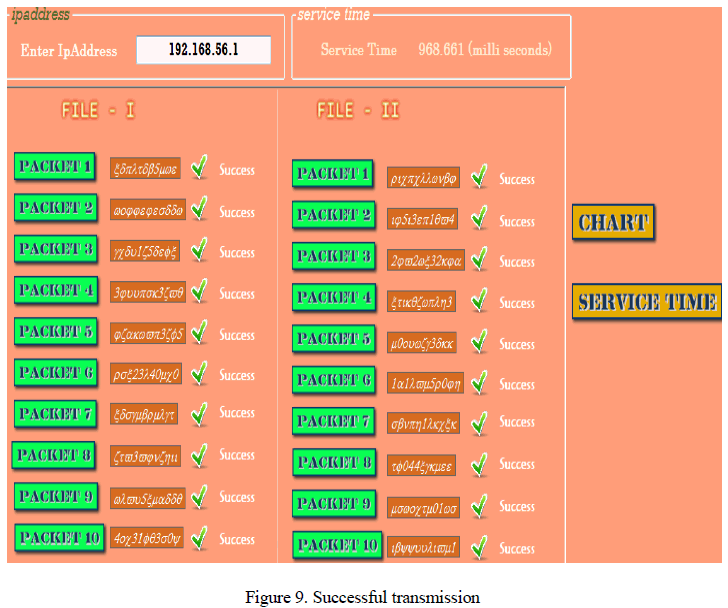 |
| Packets are received successful at the router where each file sent by server is been divided into 10 packets. |
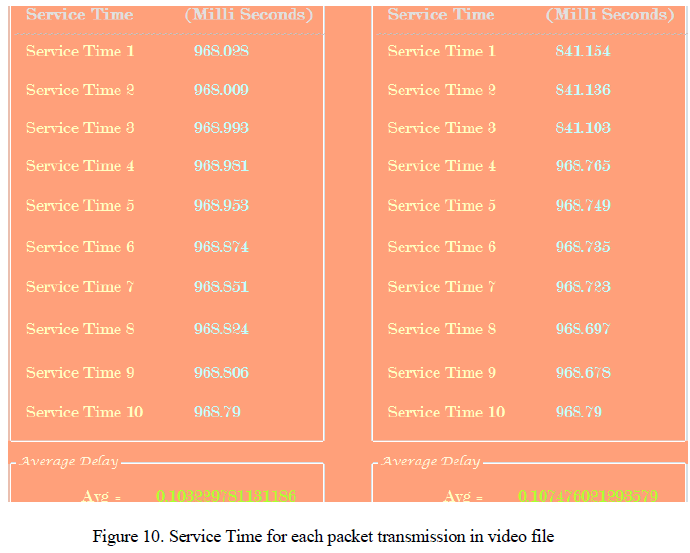 |
| Service time for each packets being sent as file is got and the average delay is calculated. |
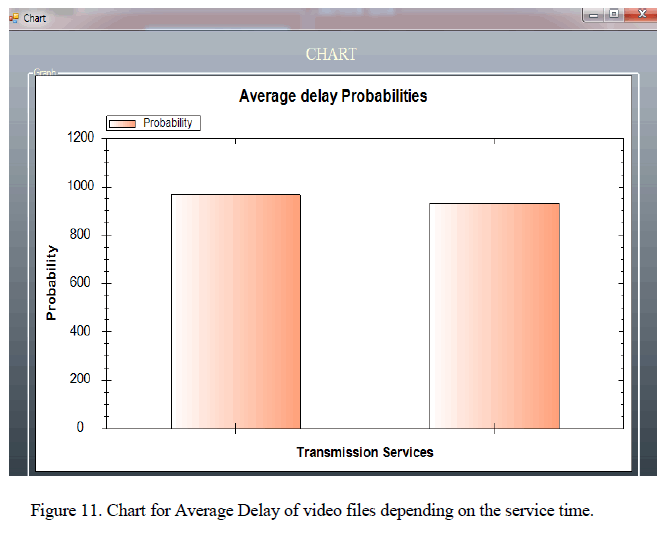 |
CONCLUSION AND FUTURE WORK |
| The Client and Servers take the IPAddr and exchange the information through Router and is implemented with adaptive parity and rate control mechanism that correctly reacts to congestion in the network based on round Trip Time, which gives better service time compared to other compressing technologies. |
| The remaining portions including image capture and encoding of image as the pixels are captured without storing can be implemented as future work. |
References |
|